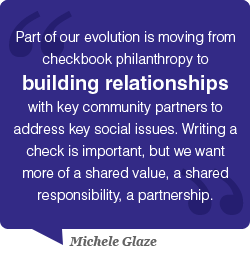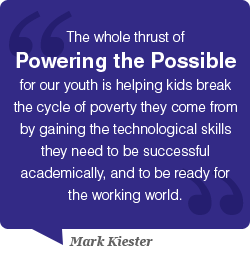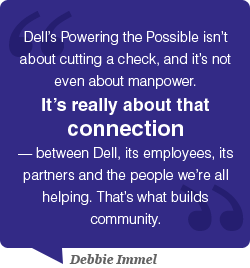![]() Dell’s Powering the Possible initiative is combining grants, volunteerism and technology to tackle many challenges facing Central Texas.
Dell’s Powering the Possible initiative is combining grants, volunteerism and technology to tackle many challenges facing Central Texas.
In this interview, Michele Glaze, the Dell North America Giving Manager; Debbie Immel, the American Red Cross of Central Texas Regional Chief Development Officer; and Mark Kiester, CEO at the Boys & Girls Clubs of the Austin Area, discuss how partnerships can help solve problems and strengthen our sense of community.
 Forefront Austin (FFA): Let’s begin with the basics. The question on the table is “Whose job is it to get things done in our community?” Michele, what is Dell’s approach to this issue, and why do you feel it’s important for corporations to be involved in their community?
Forefront Austin (FFA): Let’s begin with the basics. The question on the table is “Whose job is it to get things done in our community?” Michele, what is Dell’s approach to this issue, and why do you feel it’s important for corporations to be involved in their community?
 Michele Glaze: Philanthropy is typically something very personal, so in some ways, it’s sort of strange for companies to have a commitment to giving. But at Dell, as we consider the question of “whose job is it to get things done?” within the community, the answer is something we take very personally. We believe to be a good corporate citizen, especially as a public company, we have a responsibility to give back to the communities where we work and live, and where our customers work and live.
Michele Glaze: Philanthropy is typically something very personal, so in some ways, it’s sort of strange for companies to have a commitment to giving. But at Dell, as we consider the question of “whose job is it to get things done?” within the community, the answer is something we take very personally. We believe to be a good corporate citizen, especially as a public company, we have a responsibility to give back to the communities where we work and live, and where our customers work and live.
 Dell has grown from being an Austin-rooted high-tech startup to a multinational technology solutions company. Along the way, we’ve developed a new definition of who we are: Our purpose now is to help people and organizations grow and thrive, to help empower you to do more of what you want to do. We want to create not only that power to do more, but also possibility. We really want to focus on problems we can help solve, issues where we can make a real and important difference.
Dell has grown from being an Austin-rooted high-tech startup to a multinational technology solutions company. Along the way, we’ve developed a new definition of who we are: Our purpose now is to help people and organizations grow and thrive, to help empower you to do more of what you want to do. We want to create not only that power to do more, but also possibility. We really want to focus on problems we can help solve, issues where we can make a real and important difference.
 FFA: Which leads us to Dell’s Powering the Possible initiative. What’s the concept behind it, and what does it mean for Central Texas?
FFA: Which leads us to Dell’s Powering the Possible initiative. What’s the concept behind it, and what does it mean for Central Texas?
 Glaze: Powering the Possible is Dell’s architecture for our corporate-responsibility commitment. It begins with Dell’s pledge of 1 percent of our annual pretax profit exclusively for company giving. But another part of our evolution is moving from checkbook philanthropy to building relationships with key community partners to address key social issues. Writing a check is important, but we want more of a shared value, a shared responsibility, a partnership.
Glaze: Powering the Possible is Dell’s architecture for our corporate-responsibility commitment. It begins with Dell’s pledge of 1 percent of our annual pretax profit exclusively for company giving. But another part of our evolution is moving from checkbook philanthropy to building relationships with key community partners to address key social issues. Writing a check is important, but we want more of a shared value, a shared responsibility, a partnership.
So currently, Dell partners with about 25 different Central Texas charities through our Powering the Possible initiative, focusing on four areas where we believe we can do the most good: youth learning, social entrepreneurship, children’s cancer care and disaster relief.
 FFA: Mark, your organization is one of Dell’s community partners. What are your thoughts about the role businesses do and should play in the community? From your perspective, how’s Dell doing in the Austin area?
FFA: Mark, your organization is one of Dell’s community partners. What are your thoughts about the role businesses do and should play in the community? From your perspective, how’s Dell doing in the Austin area?
 Mark Kiester: Taking care of our community really is all our responsibility because the challenges are growing faster than anything else. In Central Texas, we have some excellent examples of those who understand that, and in the corporate world, Dell is the leader. At Boys & Girls Clubs of the Austin Area, we won a highly competitive, nationwide $215,000 youth learning grant from Dell, which we’re using to help close the tech gap for Central Texas children living in poverty. The whole thrust of Powering the Possible for our youth is helping kids break the cycle of poverty they come from by gaining the technological skills they need to be successful academically, and to be ready for the working world.
Mark Kiester: Taking care of our community really is all our responsibility because the challenges are growing faster than anything else. In Central Texas, we have some excellent examples of those who understand that, and in the corporate world, Dell is the leader. At Boys & Girls Clubs of the Austin Area, we won a highly competitive, nationwide $215,000 youth learning grant from Dell, which we’re using to help close the tech gap for Central Texas children living in poverty. The whole thrust of Powering the Possible for our youth is helping kids break the cycle of poverty they come from by gaining the technological skills they need to be successful academically, and to be ready for the working world.
 Dell is supporting — with both manpower and financial firepower — some significant programs that are developing kids in our city. But when a corporation like Dell makes the commitment to put a specified percentage of their profit back into their communities, I think it pays other huge dividends, like pride among employees and positive feelings for the company’s image among consumers. That’s part of how the community relates to them, and it contributes to our overall sense of community.
Dell is supporting — with both manpower and financial firepower — some significant programs that are developing kids in our city. But when a corporation like Dell makes the commitment to put a specified percentage of their profit back into their communities, I think it pays other huge dividends, like pride among employees and positive feelings for the company’s image among consumers. That’s part of how the community relates to them, and it contributes to our overall sense of community.
 FFA: So even though Dell has redefined its approach to giving back, does it all still really drill down to the bottom line, to how much money they invest in community programs?
FFA: So even though Dell has redefined its approach to giving back, does it all still really drill down to the bottom line, to how much money they invest in community programs?
 Debbie Immel: At the American Red Cross Central Texas Region, we can’t emphasize enough the value of Dell’s volunteer efforts. We’re run 95 percent by volunteers — and because of them, 91 cents of every dollar people donate to the Red Cross goes directly into our programs. Dell is always ready with great teams of volunteers whenever we need them – from assisting with cleanup during the Bastrop wildfires last year, to helping re-certify and ready technological equipment at our Disaster Services Maintenance Center here in Austin, so we can use that equipment to set up mobile Disaster Operations Centers (DOC) wherever disaster strikes.
Debbie Immel: At the American Red Cross Central Texas Region, we can’t emphasize enough the value of Dell’s volunteer efforts. We’re run 95 percent by volunteers — and because of them, 91 cents of every dollar people donate to the Red Cross goes directly into our programs. Dell is always ready with great teams of volunteers whenever we need them – from assisting with cleanup during the Bastrop wildfires last year, to helping re-certify and ready technological equipment at our Disaster Services Maintenance Center here in Austin, so we can use that equipment to set up mobile Disaster Operations Centers (DOC) wherever disaster strikes.
 Glaze: All of Dell’s community efforts are supported, driven and made possible by our team members. Last year, our team members donated 419,000 hours of service worldwide. This year, we beat that number with a quarter of the year still left to go. Our people are amazing.
Glaze: All of Dell’s community efforts are supported, driven and made possible by our team members. Last year, our team members donated 419,000 hours of service worldwide. This year, we beat that number with a quarter of the year still left to go. Our people are amazing.
 Kiester: Of course, people are very valuable — volunteers are essential — but when it comes to social service agencies, especially ones dealing with special populations, trained staff must come first, and trained staff costs money. While there are some volunteers with specialized skills who fit specialized programs — like our Powering the Possible partnership based around technology learning, which fits plenty of Dell volunteers perfectly — volunteers often can’t do what staff does. We have to have financial resources first; then we can find all kinds of unique opportunities for volunteers to serve.
Kiester: Of course, people are very valuable — volunteers are essential — but when it comes to social service agencies, especially ones dealing with special populations, trained staff must come first, and trained staff costs money. While there are some volunteers with specialized skills who fit specialized programs — like our Powering the Possible partnership based around technology learning, which fits plenty of Dell volunteers perfectly — volunteers often can’t do what staff does. We have to have financial resources first; then we can find all kinds of unique opportunities for volunteers to serve.
 FFA: Debbie, from the viewpoint of an organization deeply dependent upon volunteers, what are your thoughts about the balance between business donations of money versus time?
FFA: Debbie, from the viewpoint of an organization deeply dependent upon volunteers, what are your thoughts about the balance between business donations of money versus time?
 Immel: Our partnership with Dell is robust because of the way their financial and volunteer resources come together for us. For example, our longtime relationship with Dell has strengthened substantially over the past year with the grant they gave us to set up a digital operations center at our national headquarters. Dell provided everything to establish this digiDOC, which is a social media monitoring station where we monitor blogs, Facebook, Twitter, etc., to determine where needs are not yet being met out in the community when a disaster has hit.
Immel: Our partnership with Dell is robust because of the way their financial and volunteer resources come together for us. For example, our longtime relationship with Dell has strengthened substantially over the past year with the grant they gave us to set up a digital operations center at our national headquarters. Dell provided everything to establish this digiDOC, which is a social media monitoring station where we monitor blogs, Facebook, Twitter, etc., to determine where needs are not yet being met out in the community when a disaster has hit.
 Even when power goes out, people can often still access their cell phones. So at the digiDOC, we might see tweets saying ‘we have a need,’ and our virtual volunteers will communicate with those folks to determine exactly what it is they’re needing and where they are, then relay the information to our logistics team so they can deploy to the right place with the right stuff. It’s incredible what the digiDOC has done already, and we’ve barely begun to tap its potential in terms of what it can do to help us respond to disasters.
Even when power goes out, people can often still access their cell phones. So at the digiDOC, we might see tweets saying ‘we have a need,’ and our virtual volunteers will communicate with those folks to determine exactly what it is they’re needing and where they are, then relay the information to our logistics team so they can deploy to the right place with the right stuff. It’s incredible what the digiDOC has done already, and we’ve barely begun to tap its potential in terms of what it can do to help us respond to disasters.
Dell’s Powering the Possible isn’t about cutting a check, and it’s not even about manpower. It’s really about that connection — between Dell, its employees, its partners and the people we’re all helping. That’s what builds community.
 Glaze: That’s exactly it. Powering the Possible is Dell’s trifecta: It’s putting our technology solutions; our team members and their expertise; and our grant-giving to work out in the community wherever they can do the most good and make the most difference. It takes all three to link our purpose — helping people and organizations grow and thrive — with making the impossible possible, for Central Texas and all the communities we touch.
Glaze: That’s exactly it. Powering the Possible is Dell’s trifecta: It’s putting our technology solutions; our team members and their expertise; and our grant-giving to work out in the community wherever they can do the most good and make the most difference. It takes all three to link our purpose — helping people and organizations grow and thrive — with making the impossible possible, for Central Texas and all the communities we touch.







